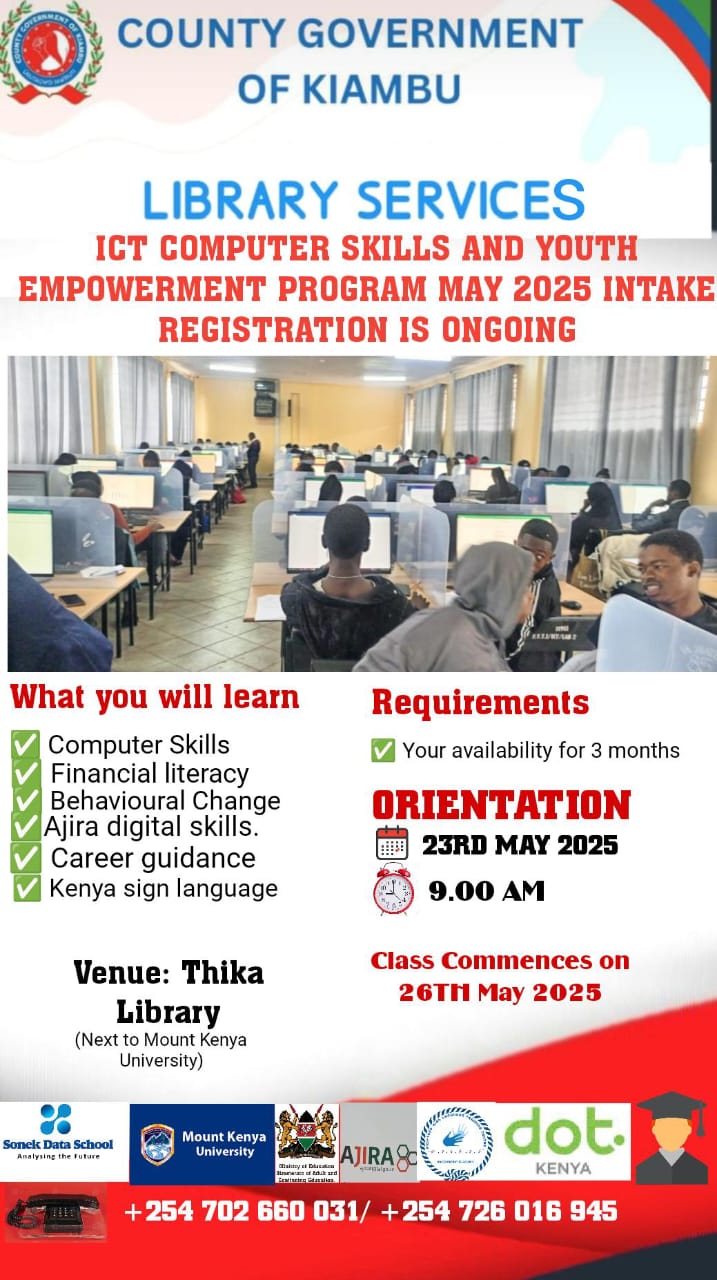Citizens Hopes of Booming Business Rises Following New Juja Farm Market
By Njeri Karu
Governor Kimani Wamatangi has decided to have dalliance with the people at the grassroots in Kiambu County, initiating development projects in the local villages and towns.
The first time Governor has become a darling of the electorate through distinctly branded ECDEs, markets, boreholes, solar lighting masts, fire stations and other projects.
In Juja Farm, the residents are set to benefit from a new modern market, which will be the first in the area since settlement began decades ago.
The Governor inspected the ongoing construction of the Juja Farm Market in Kalimoni Ward, Juja Municipality on 22nd October 2025, where he lauded the quality and pace of work.
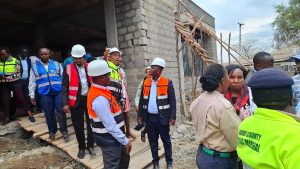
Governor Kimani Wamatangi during the inspection on the construction of the ongoing Juja Farm Market
The project is part of the county’s wider initiative to establish and upgrade markets across Kiambu to support local traders and spur economic growth.
A resident who has lived at Juja Farm since 1989 expressed her excitement about the market, saying “the long wait for a proper trading space was finally over.”
“I have never seen the government establish a market here in Juja Farm for the last 36 years. This is a first,” she said.
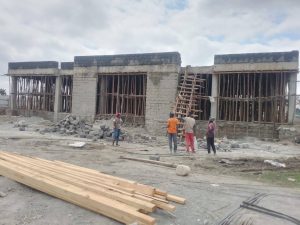
Construction of Juja Farm Market
Several markets are currently under construction, including Theta Matangini, Lusigetti, Kinoo, Dagoretti, Kagwe, Gakoe, Mataara, Karuri, Maguguni, Kiandutu, Ruaka, Kimende, Gitwe, Karia, Githiga, Kairi, Kirae and Kiganjo Phase 2.
Others such as Gituamba, Ndeiya and Kamangu have been completed and will soon be commissioned.
“This is a dream come true. We used to sell our goods from the ground, exposed to the sun and rain, but now we have hope for better business conditions,” said Margaret Waruguru, a trader from Kamangu Ward.
In addition, the county is putting up modern kiosks to expand trading spaces, including those near Thika Stadium, which are at 90% complete.
At the Lusigetti Market in Kikuyu, 100 kiosks are under construction, with two blocks already completed.
The new markets will feature amenities such as cold storage facilities, nursing rooms, and ICT hubs.
Speaking during the groundbreaking of the Kimende Modern Market, Gov Wamatangi emphasized that the projects aimed at empowering traders, creating jobs, and strengthening local commerce.
Trade CECM Susan Gatwiri reaffirmed the county’s commitment in uplifting the lives of traders, saying, “We are pleased with the progress and assure contractors of full support to ensure timely completion of these projects.”
ANOTHER WIN IN SPORTS: New Basketball Court in Thika
By Duncan Ojijo
The Governor Kimani Wamatangi administration has fulfilled another sports need for the youth and the residents of Kiambu.
Through the Department of Youth Affairs, Sports and Communication, the administration has constructed a FIBA-standard modern basketball court at Thika Stadium.
The new court is designed to provide a world-class playing surface that meets professional standards, enabling both local and regional teams to train and compete in a safe and well-equipped environment.
The court also raises the status of Thika town further noting that the town’s elevation to an Industrial Smart City was now at its final stages at the Senate.
Speaking during a recent site visit to the stadium, Chief Officer for Sports Godfrey Masolo noted that construction of the basketball court was part of the county’s broader commitment to revamping existing sports facilities and creating opportunities for youth empowerment through sports.
“This new basketball court has been designed to nurture young talent, ensure the safety of players while building discipline, teamwork, and sportsmanship in the character of our sportsmen, women and the youth,” said Mr. Masolo.
CECM Youth Affairs, Sports and Communication, Osman Korar has been in the forefront leading inspection tours of different sports facilities in the counties, including stadiums to ensure quality works are undertaken.
The works already completed at the basketball court include installation of a high-quality playing surface, quality backboards and rims, modern drainage systems, and professional court markings.

The FIBA-standard modern basketball court at Thika Stadium
Once completed, the basketball court will host training sessions and competitive tournaments, boosting Thika’s reputation as a growing sports hub in Kiambu County and the region.
Basketballer Jennifer Njeri expressed her excitement about the new court saying the investment was a great gesture by the administration in supporting talent and sports men and women.
“This court is a dream come true for many of us. Having a professional-grade facility right here in Thika means we can train better, play harder, and showcase our talent without having to travel many kilometres away,” said Ms Njeri.
The development of the Thika Stadium Basketball Court aligns with the core mandate of the Department of infrastructure development in Kiambu County.
THE JOURNEY TO KSHS 8B OWN SOURCE REVENUE (OSR)
BY MARION KANARI
Kiambu Governor Kimani Wamatangi has set an ambitious Kshs 8B own source revenue collection target for the County Government of Kiambu for the 2025/26 Financial Year, which follows achievement of Kshs5.45B revenue collected in the just concluded 2024/25 Financial Year.
During a County Revenue Stakeholders Conference, the Governor noted that Kshs 5.45B was achieved through automation of revenue collection through the Enterprise Resource Planning system, an initiative of the directorate of ICT.

For the first time, Kshs 5.45B raised as OSR in KIambu under the leadership of Governor Kimani Wamatangi
“Two years into this administration, we have unveiled a revenue collection of Kshs 5.45B, that is an 86% increment without increasing levies, fees or taxes,” said Governor Wamatangi.
Through the system, traders can pay for the now Unified Business Permits, market fees, cess, quarry, parking, County tourism sites entry and slaughter houses fees via the *476# USSD conveniently through their phones.
County Executive Committee Member (CECM) for Finance, ICT and Economic Planning Nancy Kirumba reiterated that automation of the revenue collection system improved revenue and performance, which in turn delivered impactful development projects.
CECM Kirumba further committed that the Department of Finance would provide technical and operational support required by municipalities and other County departments to achieve the Kshs 8B target in the coming financial year.

KIambu County CECM Finance Nancy Kirumba
According to CECM Kirumba the target is a foundation for service delivery, development and fiscal sustainability of the County, which requires deliberate and coordinated efforts.
In the 2024/2025 Financial Year, Governor Wamatangi’s administration in efforts to make Kiambu Great again, redirected revenue in the Department of Education to building and furnishing 309 Early Childhood Development Education Centers (ECDEs) that include PP1 and PP2 classes, kitchenette, ablution block and play area, a feeding program for 50,000 ECDE kids and training of ECDE teachers to diploma levels.
“Besides collecting revenue, we are putting the money to areas of importance in service to the people,” said Governor Wamatangi.

Governor Kimani Wamatangi during the Revenue Workshop at County HQ
The County Department of Health has completed six (6) new 180 bed capacity level IV hospitals, 26 level III hospitals and up scaled 28 former dispensaries to level III hospitals across the 12 municipalities.
The Health Department has also capped supply of drugs at County pharmacies to a minimum of 85%, equipped level II and III hospitals with computers, installed a Hospital Management Information System (HMIS) under the ERP for easier and convenient hospital operations including revenue collection, patient registry, biometrics, appointments and consultations, hospitals procurement, accounts, records and insurance reports among others.
Coincidentally, the Department of Health had the highest revenue collection in the 2024/25FY of Kshs 1.8B, with Thika Level V Hospital leading with Kshs 242M, Kiambu level V at Kshs 192M and Level II and III hospitals at Kshs 85.4M.
The Department of Lands, Physical Planning and Municipal Administration collected 1.7B, with Ruiru Municipality recording the highest improvement of 74% at Kshs Kshs 602M with Thika Municipality leading with a collection of Kshs 622M, and Juja recording Kshs 544M.
The Department of Trade, Industrialization, Tourism and Investments was the most improved in revenue collection following the automation of fees and levies and introduction of the Unified Business Permit, which has consolidated single business permits, public health, solid waste & fire making it easier for traders to pay for licenses.
While setting the Kshs 8B Own Source Revenue target for the County, Governor Wamatangi further noted that service delivery to the people has also extended working hours to almost 24/7 after the successful implementation of phase one of the Angaza Kiambu program which has seen the installation of 4,000 solar streetlights in all the 60 wards.
Meanwhile, a new batch of 4,000 solar lights installation – phase 2 – is underway and the Department of Utilities and Public Works has planned and budgeted this project. The County also has plans to solarize county boreholes, ECDEs and County premises. The County was paying an annual power bill of Kshs 700 million, and adoption of green energy has gone a long way in lowering this cost.
County Revenue Authority Chair Mburu Kangethe informed the revenue stakeholders that achieving the OSR target was evidence of a system that worked, a team that delivered and a county that was steadily maturing in fiscal discipline and accountability.

Mburu Kangethe, Chair Revenue Authority
Kiambu County Assembly Speaker Charles Thiong’o while asserting the assembly legislative support challenged the Commission on Revenue Allocation (CRA) to include Own Source Revenue as a determining factor in County revenue allocations.

Speaker Wakili Thiongo introduces MCAs during the revenue workshop at the County HQ
Although the County has achieved a first in Own Source Revenue since the advent of devolution, and is also in the journey towards collecting Kshs 8B, CRA caps Kiambu County Revenue Potential at 13.95B.

During the KIambu Revenue Workshop where Kshs 5.45B was collected in the FY 2024/25
WORLD BANK VICE PRESIDENT LAUDS KISIP 2’S TRANSFORMATIVE IMPACT IN KIAMBU COUNTY
In the heart of Umoja—one of Kiambu County’s most densely populated informal settlements—a remarkable transformation is underway.

Umoja Settlement in Thika Municipality
Paved roads have replaced dusty paths, solar lights now brighten once-dark alleys, and clean, flowing sewer lines have ended years of neglect.
During a visit to Umoja Settlement in Thika Municipality, World Bank Group Vice President and Chief Risk Officer Dennis McLaughlin commended the Second Kenya Informal Settlements Improvement Project (KISIP 2) for its transformative impact.
Accompanied by Kiambu Governor H.E. Dr. Kimani Wamatangi, World Bank officials, and the National Project Coordination Team led by National Project Coordinator George Arwa, McLaughlin inspected several ongoing projects valued at Ksh. 900 million.

The World Bank Group Vice President and Kiambu Governor Kimani Wamatangi at the Umoja Settlement in Thika Municipality
McLaughlin reaffirmed the World Bank’s commitment to uplifting vulnerable communities, stating, “Our vision is to see informal settlement residents connected to the world—accessing services, working, and thriving like any other citizen. We are dedicated to supporting infrastructure upgrades that improve living conditions and create sustainable income opportunities.”
Governor Wamatangi echoed the importance of the partnership with the World Bank and Agence Française de Dévelopment (AFD), noting: “We are proud of this collaboration and fully committed to the transparent and effective implementation of these projects. This partnership goes beyond infrastructure; it restores dignity, hope, and opportunity.”
He appreciated the World Group Vice President and the World Bank for their belief in the potential of Kiambu’s residents.
KISIP 2 is actively upgrading infrastructure in five informal settlements across Kiambu County—Umoja, Kiang’ombe, Bosnia, Fort Jesus, and Misri. The project includes tarmacked and cabro-paved roads, pedestrian footpaths, drainage systems, and solar-powered street lighting—significantly improving safety, mobility, and quality of life.
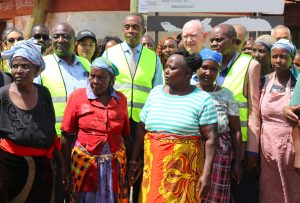
The World Bank Group Vice President and Kiambu Governor Kimani Wamatangi, and some of the residents at the Umoja Settlement in Thika Municipality
National Project Coordinator George Arwa emphasized the broader impact of the initiative: “Starting with issuing title deeds in Umoja, we’ve given residents a sense of ownership and security. Infrastructure upgrades like roads, security lights, and drainage have empowered residents to access bank loans and invest in their properties with confidence.”
For residents like Mary Njeri, a mother of three who has lived in Umoja for over a decade, the transformation represents more than infrastructure; it symbolizes recognition and hope.
“We feel seen,” she says with emotion. “For the first time, we’re not forgotten. Our children finally have a place they can grow up in and be proud of.”
In addition to infrastructure development, KISIP 2 is implementing land tenure regularization in five other settlements: Matharau, Kiandutu, Kanjeru, Kiamburi, and Shauriyako Kiroe. Over 6,000 title deeds are currently in the final stages of production. With survey plans approved by the County Assembly and under review by the Survey of Kenya, thousands of residents stand to benefit from secure land ownership.
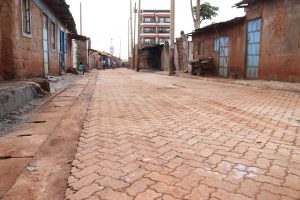
The transformed pathways at the Umoja Settlement Scheme
KISIP 2 is also spearheading the development of a comprehensive, specific slum upgrading strategy for Kiambu County. This strategy will guide land use planning, strengthen tenure security, improve infrastructure and social amenities, and support the delivery of adequate housing.
Key pillars of the strategy include climate resilience, environmental stewardship, participatory planning, sustainable livelihoods, and the establishment of a coordinated multi-stakeholder institutional framework. Scheduled for implementation over a ten-year period, the strategy also promotes equity, inclusivity, transparency, devolution, public participation, and strategic partnerships.
Governor Wamatangi described KISIP 2 as a “game changer” for informal settlements in Kiambu, enhancing access to basic services and secure land tenure. He emphasized the county’s robust monitoring mechanisms, ensuring the responsible use of funds and long-term impact for residents.
By: Enock Maroa (PCO)
County Government of Kiambu
County Continues Working on Markets
By Njeri Karu
The County Government of Kiambu Department of Trade, Industrialization, Tourism and Investments handed over construction sites at Gakoe and Mataara markets in Gatundu North Sub-County, Kamangu market in Kikuyu Sub-County, and Karuri Market in Kiambaa Sub-County on 26th March 2025.
This signaled the commencement of construction of critical infrastructure for business and entrepreneurship, and also the creation of thousands of employment opportunities. The new markets and infrastructure would align with the department’s vision and the Governor’s manifesto to enhance trading conditions and support local businesses.
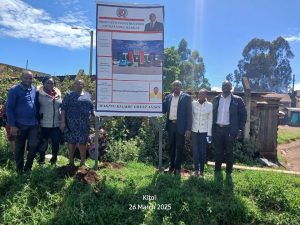
Mataara Market
The state-of-the-art modern markets would individually accommodate over 300 traders and offer a range of amenities that include stalls, nursing rooms, ICT hubs, and cold storage rooms, among others.
“We look forward to seeing this projects come to life and the impact they will have on our local economy. These traders have for years been affected by weather elements while carrying out their businesses but that will soon be a thing of the past.”
“We will provide a temporary location where they will operate their businesses while awaiting the completion of the new markets,” said CECM Trade Susan Gatwiri during the site handover at Gakoe market.
In addition, the department conducted site visits at Ruaka market in Kiambaa Sub-County, Kimende market in Lari Sub-County, Rironi market in Lari Sub-County, Juja farm market in Juja Sub-County, Githiga, Karia and Kigumo markets in Githunguri Sub-County, Kiandutu market in Thika Sub-County, Kiganjo and Gitwe markets in Gatundu South Sub-County with the aim of informing contractors on the scope of the projects and enabling them to take note of salient features that will inform their bidding.
Kiambu Bursary Kitty Grows to Half a Billion, Benefitting Thousands of Vulnerable Households
By Ann Karanja
For years, vulnerable children in Kiambu County have had to overcome insurmountable challenges in the quest for an education.
However, their plight has significantly changed since the reins of power, in the populous county, were taken over by Governor Kimani Wamatangi administration.
Under the new leadership, the kitty for education bursaries targeting the vulnerable has been increased from KES. 100 million to KES. 500 million.
This development has seen the number of beneficiaries grow in multiples across the 60 wards of Kiambu County, and the amount increased to at least KES. 5,000 for every beneficiary.
In addition, the bursaries are domiciled in the Directorate of Social Services which empowers persons with disabilities (PWDs) giving them priority in the allocation process.
The vision of Governor Wamatangi’s administration is to see that no child is left behind because of financial constraints, which aligns with the United Nations (UN) mandate, and also as contained in his 2022 Campaign Manifesto.
Governor Wamatangi, who grew in a humble background, appreciates that education is the ultimate equalizer, and believes all children must be given a fair chance to get an education.
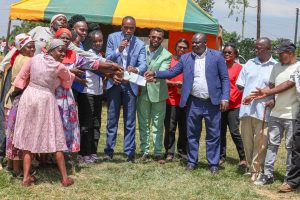
BURSARY ISSUANCE IN KIAMBU COUNTY
Past mid-March 2025, the bursary exercise had covered 52 wards and benefitted more than 14,000 students from different backgrounds.
“My administration is giving bursary cheques of the least amount, KES. 5,000 for every beneficiary, and are distributed five times in a year. We also have a system for bursary issuance that ensures fairness and equality for all,” said Governor Wamatangi.
In the past, parents queued for hours, struggling to get bursary cheques, which were most times elusive, and those who managed received negligible amounts.
In addition to the general bursaries, the Governor Wamatangi administration provides special full scholarships to students in the most vulnerable conditions. These students, often orphans or from extremely dire conditions receive comprehensive financial support to ensure their educational journey is uninterrupted.
This bursary issuance underscores the Governor’s commitment to building an inclusive and equitable society where education is accessible to all, regardless of socioeconomic status.
“Education is the key to unlocking a brighter future for our county and our nation. Our responsibility is to ensure that every child, no matter their background, has the opportunity to realize their full potential. These bursaries are a step towards making that vision a reality,” said Governor Wamatangi during a bursary issuance exercise.
Chief Officer Vocational Training, Gender & Social Services, Ms Emily Nkoroi has continuously expressed her commitment to ensuring that social status does not hinder students from chasing after their dreams.
Parents and students have expressed their gratitude for the timely support noting that it is a true reflection of leadership that listens and acts in the best interest of her people.
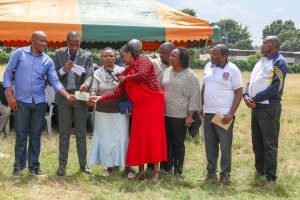
BURSARY ISSUANCE IN KIAMBU COUNTY
With the bursary exercise continuing to roll out in the remaining eight (8) wards, it is expected that even more students will benefit, securing educational opportunities for thousands.
DIALYSIS MACHINES: Governor Wamatangi Administration Multiplies Opportunities for Cleaning Your Blood
BY KELVIN KIMARU
In yet another breakthrough for healthcare in Kiambu County, Governor Kimani Wamatangi’s administration has expanded dialysis services at Thika Level V Hospital by procuring five new dialysis machines.
This acquisition highlights the Governor’s commitment to strengthening healthcare infrastructure and ensuring that patients battling kidney disease receive timely and quality treatment.
For years, the facility has served as a referral center for dialysis patients, often struggling with limited equipment. The new machines are expected to ease congestion, reduce wait times, and accommodate more patients from Kiambu and neighboring counties.
Speaking to our team, a beneficiary undergoing dialysis expressed relief at the improvements.
“Before, we had to wait long hours, and sometimes even miss sessions due to the high number of patients. But now, things are much better. The new machines have helped us,” she said.
According to Nephrology Nurse Joyce Mwangi the upgrade has significantly improved efficiency in service delivery.
“With the new machines, we have reduced patient wait times and can now handle more cases daily. This is a big step towards improving renal care in the county,” she stated.
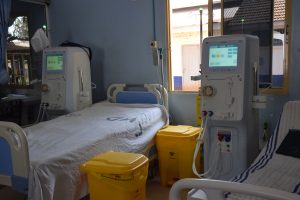
Despite this progress, the demand for dialysis services remains high, with patients traveling from neighboring counties; Nairobi, Muranga, Machakos, and Kirinyaga to seek treatment at the facility.
Governor Wamatangi’s administration has prioritized healthcare as a key pillar of development, and this latest investment in dialysis services is yet another demonstration of his dedication to improving the lives of Kiambu residents.
Transforming Kikuyu through #AngazaKiambu Solar Streetlighting
By Marion Kanari
Senior Public Communications Officer
As the world embraces renewable energy to save the planet from the effects of climate change, Kiambu County is not left behind.
One of the county’s key flagship projects is the adoption of solar energy, a significant shift in operations geared towards sustainability on all fronts.
The Department of Public Works and Utilities has rolled out phase one of the ambitious #AngazaKiambu program, which involves installing over 60 solar streetlights per ward in the 12 Sub Counties totaling 4,000.
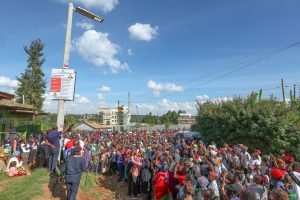
Solar streetlighting in Kikuyu under the Governor Kimani Wamatangi administration
On this second week of February 2025, Governor Kimani Wamatangi led the launching of solar streetlights in the five wards of Kikuyu Municipality, where he noted that phase two and three of the program would be launched in March and May 2025 respectively.
The Governor Kimani Wamatangi administration will have installed 10,000 solar streetlights in the three phases of the Angaza Kiambu Program.
“We have phased out the installation of the solar streetlights to strategically light up as many areas as possible,” said Governor Wamatangi.
While reiterating Governor Wamatangi’s sentiments, local MCAs hailed the program citing improved security and ease of doing business for the residents.
Chief Officer Public Works & Utilities Virginia Kahonge noted that installation works had been completed in seven (7) municipalities, and phase one would be completed by mid-March 2025.
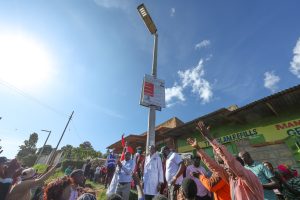
Solar streetlighting in Kikuyu under the Governor Kimani Wamatangi administration
The lights installed along critical areas as guided by area residents are distributed as follows in Kikuyu Municipality:
Karai Ward;-
- Rio Nderi Kagiria Rd
- Muhuri road
- Thiru Njiwa Rd
Nachu Ward;-
- Shell Petrol Station – Nachu Primary School Rd
- Kianjage Rd
- Kiagatta Past Lusigetti hospital
- Lenguti High School Kanyayo
- Jambu TV area
Sigona Ward
- Gikira access Rd
- Gachuti Rd
- Wega Banda Homes
- Gitau Thamanda Rd
Kinoo Ward
- Kangoro Rd
- Kinoo PCEA area
- Kariango area
Kikuyu Ward
- Kidfarmaco highland
- Link Rd
- Thogoto Ndaire Rd
- Kianda Kia Reli
- St Teresa
The Solar streetlights, which are county-specific and custom-made have improved lighting and enhanced safety, require minimal and less frequent maintenance in comparison to the grid-connected lights, have a reduced carbon footprint, and use solar energy.
The public funds saved from the paying high power bills would be channeled to development projects, and other critical areas of the County to spur economic development.
County Assembly Majority Leader MCA Godfrey Muceke lauded the #AngazaKiambu initiative as one of a kind saying the administration had outdone previous governments in the implementation of impactful projects.
The County’s shift to clean energy was necessitated by unsustainable power and maintenance bills for the existing 20,428 grid-connected lights, boreholes, hospitals, county premises, and other operations.
The County has an annual estimated power bill of over KES. 1.4B which stems from its 120 hospitals, 19,000 Streetlights, County offices and fire stations.
Under the directive by Governor Wamatangi, community boreholes are also being solarized, and BQs for new county buildings now require solar lighting.
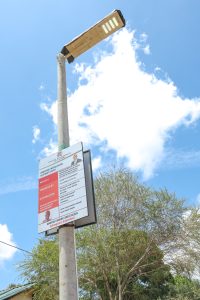
Solar streetlighting in Kikuyu under the Governor Kimani Wamatangi administration
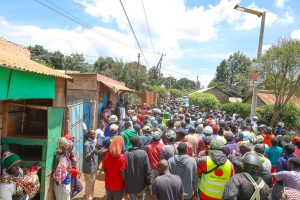
Solar streetlighting in Kikuyu under the Governor Kimani Wamatangi administration
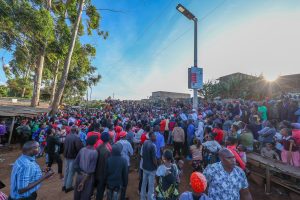
Solar streetlighting in Kikuyu under the Governor Kimani Wamatangi administration
New Medical Equipment Will Save Thousands of Lives
The County Government of Kiambu started the year 2025 on a high crescendo in health by launching new medical equipment.
During an event held at the Kiambu HQ on 10th January 2025, Governor Kimani Wamatangi launched the equipment, which included endoscopy, digital x-ray, and dialysis machines.
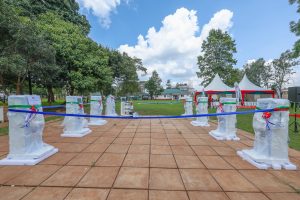
State-of-the-art medical equipment, Kiambu County
The machines would devolve quality health and better patient care to the grassroots, transforming health in villages of Kiambu where some hospitals have never been installed with such state-of-the-art machines.
Some hospitals that would benefit include Kiambu Level V, Gatundu Level V, Thika Level V, Lari Level IV, and Lussigette Level IV hospitals.
For the first time, Kiambu Level V Hospital would have an endoscopy machine enabling doctors to perform non-intrusive medical procedures using cameras for the overall safety and well-being of thousands of patients, and also reduce the need to travel abroad for such specialized services.
The launch was also attended by Deputy Governor Rosemary Kirika, Members of the County Assembly led by Deputy Speaker John Njiru, CECM Health Dr. Elias Maina, county officials, municipal managers, members of the public, health care workers, and partners from the medical field.
“The dialysis machines and the rest of the machines are the best gifts you can give the people of Kiambu in this New Year,” said Dr. Maina.
MCA Njiru urged the people to desist from playing politics with matters of health as he appreciated the equipping of hospitals with the equipment.
In his speech, Governor Wamatangi assured of rapid action to continue improving health in the county including installation of a CT-Scan machine at the Kiambu Level V Hospital.
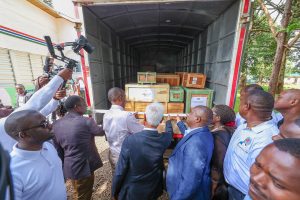
Governor Wamatangi launches the digital xray machines at Kiambu HQ
“We have plans to install a CT-Scan machine here at the Kiambu hospital in a few months, and also replace the CT-Scan machine in Thika because of the condition of the machine, old and depleted,” said Governor Wamatangi.
In addition, the Governor enumerated the growth in the number of hospitals through the establishment of new facilities, rehabilitation of the existing ones, and reviving the stalled hospitals.
Other successes included payment of the one billion KEMSA bill that the county owed before the new administration came into office, operationalization of ambulances, and ensuring at least 85% stock of pharmaceuticals and medicines in health facilities.
In the first phase, equipment worth KES. 500 million were delivered to county hospitals including x-ray machines, dental equipment, ultrasound machines, and other assorted equipment.































